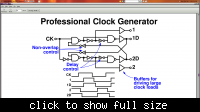juneja
Junior Member level 2
I am trying to make a two-phase non overlapping clock generator for my SC integrator. can u plz tell me why people use such a professional clock generator as this one:

(image also at : https://obrazki.elektroda.pl/46_1318777833.png)
when even this one can work:

(image also at url: https://obrazki.elektroda.pl/48_1318777922.jpg)
??? i am unable to find the answer myself and fear that the second one may give up in silicon.
thanks.

(image also at : https://obrazki.elektroda.pl/46_1318777833.png)
when even this one can work:

(image also at url: https://obrazki.elektroda.pl/48_1318777922.jpg)
??? i am unable to find the answer myself and fear that the second one may give up in silicon.
thanks.